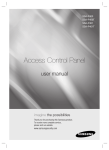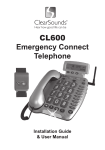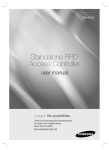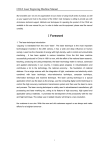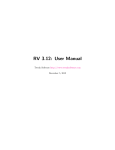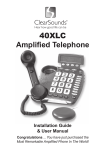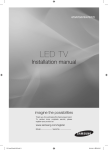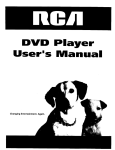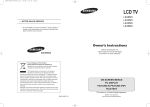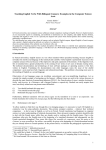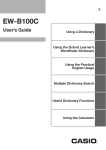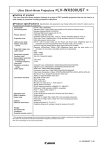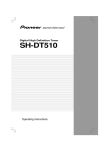Download - Changhong
Transcript
4500 3D55B4500i 签名 设计 审核 电路会签 软件会签 工艺会签 结构会签 通知编号 图号 规格 封面纸张 内文纸张 机芯 广制TZ0212 JUC0.018.00082931 A5 157g铜版纸彩印 70g双胶纸黑白印刷 LS10+3D 日期 Table of Contents Warning 1 Safety Instructions 3 Main Unit Control 5 Front Panel Rear & Sides Panel 5 6 Remote Control 7 Getting Started 10 Using the Remote Control 10 Installing Batteries in the Remote Control 10 Battery Replacement 10 Connection and Setup 11 Connecting the Power Cord 11 Connecting Antenna and Other Devices 11 Basic Operation 13 QUICK START GUIDE Turning on and off the TV Programme Selection Volume Adjustment Changing the Input Source 13 14 14 14 14 Menu Operation 15 How to Navigate Menus Configuring the Channel Menu Configuring the Picture Menu Configuring the Sound Menu Network Function Operation Instruction Configuring the Option Menu PVR Function Operation Instruction Configuring the Lock Menu Viewing TV using the 3D function Using USB Mode Hotel Mode 15 15 16 17 18 33 34 38 38 41 43 Important Unique Buttons 44 Programme Guide Channel List Favorite List 44 44 44 Teletext 45 Using the Teletext Feature 45 Troubleshooting Guide 46 Troubleshooting Maintenance 46 47 Securing the TV to the Wall 48 English Warning CAUTION RISK OF ELECTRIC SHOCK DO NOT OPEN WARNING: TO REDUCE THE RISK OF ELECTRIC SHOCK DO NOT REMOVE COVER (OR BACK). NO USER SERVICEABLE PARTS INSIDE. REFER TO QUALIFIED SERVICE PERSONNEL. The lightning flash with arrowhead symbol, within an equilateral triangle, is intended to alert the user to the presence of uninsulated "dangerous voltage" within the products enclosure that may be of sufficient magnitude to constitute a risk of electric shock to persons. The exclamation point within an equilateral triangle is intended to alert the user to the presence of important operating and maintenance (servicing) instructions in the literature accompanying the appliance. REGULATORY INFORMATION This equipment generates uses and can radiate radio frequency energy and, if not installed and used in accordance with the instructions, may cause harmful interference to radio communication. However, there is no guarantee that interference will not occur in a particular installation. If this equipment does cause harmful interference to radio or television reception, which can be determined by turning the equipment off and on, the user is encouraged to try to correct the interference by one or more of the following measures: -Relocate the receiving antenna. -Increase the separation between the equipment and receiver. -Connect the equipment into an outlet on a circuit different from that to which the receiver is connected. -Consult the dealer or experienced radio/TV technician for help. Any changes or modifications not expressly approved by the party responsible for compliance could void the user's authority to operate the equipment. CAUTION DO not attempt to modify this product in any way without written authorization from supplier. Unauthorized modification could void the user's authority to operate this product. It is not recommended to keep a certain still image displayed on the screen for a long time as well as displaying extremely bright images on screen. Figures and illustrations in this User Manual are provided for reference only and may differ from actual product appearance. Product design and specifications may be changed without notice. English1 Warning WARNING To Reduce The Risk Of Fire Or Electric Shock, Do Not Expose This Apparatus To Rain Or Moisture. The ventilation should not be impeded by covering the ventilation openings with items, such as newspapers, table-cloths, curtains, etc. The Apparatus shall not be exposed to dripping or splashing and that no objects filled with liquids, such as vases, shall be placed on the apparatus. Attention should be drawn to the environmental aspects of battery disposal. Don’t throw used batteries in dustbin. Please contact your retailer in order to protect the environment. Keep minimum distances (5cm) around the apparatus for sufficient ventilation; (Minimum distance around the apparatus for sufficient ventilation.) No naked flame sources, such as lighted candles, should be placed on the apparatus; To prevent the spread of fire, keep candles or other open flames away from this product at all times. The device may be malfunction when under electrostatic discharge. It can be manually resumed by power off and power on again. CAUTION connecting the Power Cord Most appliances recommend they be placed upon a dedicated circuit; that is, a single outlet circuit which powers only that appliance and has no additional outlets or branch circuits. Do not overload wall outlets. Overloaded wall outlets, loose or damaged wall outlets, extension cords, frayed power cords, or damaged or cracked wire insulation are dangerous. Any of these conditions could result in electric shock or fire. Periodically examine the cord of your appliance, and its if appearance indicates damage or deterioration, unplug it, discontinue use of the appliance, and have the cord replaced with an exact replacement part by an authorized servicer. Protect the power cord from physical or mechanical abuse, such as being twisted, kinked, pinched, closed in a door, or walked upon. Pay particular attention to plugs, wall outlets, and the point where the cord exits the appliance. The MAINS plug is used as the disconnect device, and the disconnect device shall remain readily operable. is a trademark of SRS Labs, Inc. TruSurr ound HD technology is incorporated under licens e from SRS Labs, Inc. English2 Safety instructions IMPORTANT SAFETY INSTRUCTIONS 1. Read these instructions. 2. Keep these instructions. 3. Heed all warnings. 4. Follow all instructions. 7. Do not block any of the ventilation openings. Install in accordance with the manufacturer's instructions. 5. Do not use this apparatus near water. 8. Do not install near any heat source such as radiators, heat registers, stoves, or other apparatus (including amplifiers) that produce heat. 6. Clean only with a dry cloth. 9. Do not defeat the safety purpose of the polarized or grounding type plug. A polarized plug has two blades with one wider than other. A grounding type plug has two blades and a third grounding prong. The wide blade or the third prong is provided for your safety. When the provided plug does not fit into your outlet, consult an electrician for replacement of the obsolete outlet. English3 Safety instructions 10. Protect the power cord from being walked on or pinched particularly at plugs, convenience receptacles, and the point where they exit from the apparatus. 13. Unplug this apparatus during lightning storms or when unused for long periods of time. 11. Only use the attachments/ accessories specified by the manufacturer. 14. Refer all servicing to qualified service personnel. Servicing is required when the apparatus has been damaged in any way, such as power supply cord or plug is damaged, liquid has been spilled or objects have fallen into the apparatus, the apparatus has been exposed to rain or moisture, does not operate normally, or has been dropped. 12. Use only with a cart, stand, tripod, bracket, or table specified by the manufacturer, or sold with the apparatus. When a cart is used, use caution when moving the cart/ apparatus combination to avoid injury from tip-over. ON DISPOSAL -The fluorescent lamp used in this product contain a small amount of mercury. -Do not dispose of this product with general household waste. -Disposal of this product must be carried out in accordance to the regulations of your local authority. NOTE -If the TV feel cold to the touch, there may be a small "flicker" when it is turned on. This is normal, there is nothing wrong with TV. -Some minute dot defects may be visible on the screen, appearing as tiny red, green, or blue spots. However there have no adverse effect on the monitor's performance. -Avoid touching the screen or holding your finger(s) against it for long periods of time. Doing so may produce some temporary distortion effect on the screen. English4 Main Unit Control Front Panel 1 2 3 4 5 6 No. Name 1 CH+/CH- 2 VOL+/VOL- 3 MENU Description Changes the channels. Adjusts the volume. Open the menu. To switch the signal source. In the on-screen menu, use this 4 button as you would use the ENTER button on the remote control. 5 6 Turns the unit on and off Power&Sensor Power Indicator and Infrared sensor English5 Main Unit Control Rear & Sides Panel 12 12 8 14 13 13 15 16 7 8 8 No. Name 7 LAN 8 HDMI 9 AV OUT PC/DVI AUDIO/ PC 10 11 ANT 12 USB 13 AV 14 COMPONENT DIGITAL AUDIO OUT 10 11 Description Local area network (LAN) port. Connect a LAN cable to this port to connect to the Network. HDMI input AV audio/video signal output PC input Antenna input USB port. Connector for USB Play. You can connect to network wirelessly using the Wireless LAN Adapter. AV audio/video signal input. When connecting, use the appropriate connector. Component input. When connecting, use the appropriate connector. Headphone output 15 16 10 9 SPDIF port English6 Remote Control The buttons of the original remote control are as following: 2 1 1 2 3 4 5 6 7 8 9 0 4. 3 AUDIO SOURCE 4 5 REPEAT 6 8 10 12 LIST INDEX T-Shift MENU EPG EXIT 15 16 VOL INFO CH 19 - 3D S.MODE 7. + HOME 20 22 6. 17 + 18 5. 7 9 11 13 ENTER 14 1. 2. 3. P.MODE i 21 23 8. 24 STILL SUBTITLE 25 27 29 31 RADIO 26 28 30 9. 10. 11. 12. 13. 14. 15. 16. 17. 18. 19. : Power, switch on or off TV set. : Press to mute or restore sound. NUMBER BUTTONS: Choose channels or password importation. SOURCE: Press to select signal source. ? : Reveal the hidden information of some teletext pages. AUDIO (∞I/II): The button can be used to switch between NICAM DUALⅠ/ NICAM DUALⅡ/ NICAM DUALⅠ+Ⅱ/MONO and switch Audio language in DTV mode. AUDIO: Select the audio language if available (in USB mode). LIST: Press to call up the channel list. Press again to exit it. REPEAT: Press to select the repeat play mode (in USB mode). T-Shift: Press T-Shift button to start time shift function. INDEX: Press to enter the Recorded list. (In PVR mode) Change the list by TIME or CHANNEL (In PROGRAMME GUIDE menu). : Press button to start recording. MENU: Press to enter the menu screen for various optional adjustable settings. EXIT: Return the last layer OSD Menu or exit OSD Menu. EPG: Electronic Programme Guide, use in the DTV mode. : Switch on/off the favorite programs list. ▲/▼/◄/►: To select the direction. ENTER: Press to execute the selected item in the menu screen or enter the desired value in any input mode. 3D: Opens 3D menu. HOME : Accesses the Home menu. VOL+/VOL-: Press to adjust the volume level up or down. CH+/CH-: Press to select channels in ascending or descending order. Moves to the previous or next screen in some list. English7 Remote Control 2 1 1 2 3 5 6 7 4 3 4 8 AUDIO SOURCE 5 0 9 REPEAT 6 8 10 12 LIST INDEX T-Shift MENU EPG EXIT 7 9 11 13 15 ENTER 14 16 17 + 18 VOL CH 20 22 INFO + HOME S.MODE 19 - 3D P.MODE i 21 23 24 STILL SUBTITLE 25 27 29 31 RADIO 26 28 30 20. S.MODE: Changes the sound mode. 21. P.MODE: Changes the image mode. 22. INFO: Press to display the current programme information on the screen. i : Go to the index page. : Return to last viewed program. 23. 24. COLOR BUTTONS: Red/ green/ yellow/ blue key navigation link. : Fast reverse (in USB mode). : Fast forward (in USB mode). : Previous (in USB mode). : Next (in USB mode). : Enter the Teletext, press again for 25. MIX mode, press this button again to exit. : Play (in USB/PVR mode). 26. : Enter subtitle mode or subpage. SUBTITLE: Select the subtitle language if available (in USB mode). 27. RADIO: Press to interchange Radio and DTV programs when there is Radio program (In DTV mode). 28. STILL: Press to hold the picture. : Hold the teletext page on display, press again to release. : Stop (in USB/PVR mode). : Cancel the teletext but not to exit 29. teletext, press again to exit. 30. : Press to select different images sizes. : Change size of teletext screen in display mode. 31. : Pause (in USB/PVR mode). English8 Remote Control 31. : Switch between front and back side. 32. CAPS: Switch between uppercase and lowercase. W 2 ! - E D C 34. 3 # = : Space Buttons. 35. Letters and characters key : Enters letters, R F V 4 / numbers or symbols. T G B 5 % _ Y H N 35 6 & “ 36. : Enter Buttons. 37. : Backspace Buttons. U J M , 7 * ‘ I K . 8 ( : WWW. O L 9 ) @ P 0 .com 36 1 S X 34 33. ALT: Press the "ALT" button first,then you can change/shift the function of this button Q 1 between "Q" and"1". Q ? + ALT 33 CAPS 32 A Z 31 37 NOTE: • All pictures in this manual are examples, only for reference, actual product may differ from the pictures. • The buttons not mentioned here are not used. • "www." and ".com" keys on remote control can be only used in the TV Internet Browser. English9 Getting Started Using the Remote Control When using the remote control, aim it at remote sensor on the television. If there is an object between the remote control and the remote sensor on the unit, the unit may not operate. • Point the remote control at the REMOTE SENSOR located on the television. • When using this television in a very brightly lit area, the infrared REMOTE CONTROL SENSOR may not work properly. • The recommended effective distance for using the remote control is about 7 metres. REMOTE SENSOR Installing Batteries in the Remote Control 1. Open the cover at the back of the remote control. 2. Install two AAA size batteries. Make sure to match the “+” and “-” ends of the batteries with the diagram inside the compartment. 3. Replace the cover. Battery Replacement You will need to install the batteries into the remote control to make it operate following the instruction below. When the batteries become weak, the operating distance of the remote control will be greatly reduced and you will need to replace the batteries. Notes on Using Batteries: The use of the wrong type of batteries may cause chemical leakage and/or explosion. Please note the following: • Always ensure that the batteries are inserted with the + and - terminals in the correct direction as shown in the battery compartment. • Different types of batteries have different characteristics. Do not mix different types. • Do not mix old and new batteries. Mixing old and new batteries will shorten battery life and/or cause chemical leakage. • Replace batteries as soon as they do not work. • Chemicals which leak from batteries may cause skin irritation. If any chemical matter seeps out of the batteries, wipe it up immediately with a dry cloth. • The batteries may have a shorter life expectancy due to storage conditions. Remove the batteries whenever you anticipate that the remote control will not be used for an extended period. • The batteries (battery pack or batteries installed) shall not be exposed to excessive heat such as sunshine, fire or the like. CAUTION: • It may result in an explosion if batteries are replaced incorrectly. • Only replace batteries with the same or equivalent type. English10 Connection and Setup Connecting the Power Cord 1.Connect the power cord with 240V power supply. 2.Turn on the power switch of the TV. NOTE: • The power input for the TV is 240V~ 50/60Hz. • Be sure the power cord is disconnected and the TV is switched on before making connections. • To be completely disconnected from the supply mains, the mains plug of the television should be disconnected from the mains socket outlet completely. Connecting Antenna and Other Devices The equipment with HDMI output function RF Coaxial Wire(75 ohm) Audio R Video Cable modem Audio L Router The equipment with AV input function @ Internet USB Drive/ Wireless LAN Adapter Audio R SPDIF The equipment with AV output function (such as VCR, DVD, set-top boxes, etc.). English11 Y Pr/Cr Pb/Cb Audio R Audio L Video Audio R The equipment with HDMI output function The equipment with Component output function Audio L USB Drive/ Wireless LAN Adapter Video ETHERNET LAN Audio L WAN Computer The equipment with HDMI output function The equipment with AV output function (such as VCR, DVD, set-top boxes, etc.). Connection and Setup NOTE: • When using digital audio optical output socket, please note the plug direction which should be in accordance with the socket. Otherwise the socket would be easily damaged for the improper operation. • Make sure that all the components are connected correctly. • For receiving free to air TV broadcasts, we recommend that you use an external fixed antenna. Should you require the use of a temporary antenna, please ensure that you purchase an antenna with sufficient ability to receive in weak signal areas. Only when you are in close proximity to a transmitter will a temporary antenna reproduce a signal as strongly as a fixed antenna. A digital antenna on the roof is recommended. • Component and AV1 can not be used at same time for they share of one audio channel. English12 Basic Operation QUICK START GUIDE ■ Connection 1.Connecting the mains and antenna. 2.If TV has a power switch, turn it on firstly. ■ Initial Setup When the TV is initially powered on (with no preset channels), a sequence of on-screen prompts will assist in configuring basic settings. Press the◄/►button to select Picture Mode, then press the ENTER button to start Channel Tuning. If you missed the setup, you need to do an auto search as follows: 1. Press SOURCE button, you will see a list. Press the▲/▼to highlight DTV then press ENTER. 2. Then press the MENU button to bring the TV menu up. Press the◄/►to highlight CHANNEL on the very left, and press ENTER. 3. Press the▲/▼to highlight Auto Tuning, then press ENTER. 4. Press the▲/▼/◄/►button to select the country and tune type, then press the ENTER button to start Auto Tuning. 5. After that, a Channel Tuning Frame will come up and it will take you about 5 minutes to get all the channels that will be saved in the TV system automatically. NOTE: • If the TV doesn't receive any channels, please check your aerial connection or the country you selected, then try an auto search again. • If the TV just receives some of the channels, it means the aerial's reception isn't good enough and an antenna service is recommended. • If you need any help with the setting, please give us a call 1300796688. English13 Basic Operation Turning on and off the TV ■ Turn on the TV Connect the TV to your mains socket. If TV has a power switch,turn it on firstly. button on the remote to turn on the TV. Then press the ■ Turn off the TV Press the button on the remote control to enter standby mode. Do not leave your set in standby mode for long periods of time. It is best to unplug the set from the mains and aerial. When there is an accident power off, it is recommended to unplug the power cable from the power socket. ■ No signal There is No Signal menu on screen when there is no input signal. In ATV mode, if there is no signal in five minutes, the TV will turn off automatically. In PC-RGB mode, the TV set will automatically turn off in 30 seconds if no input signal. When VGA cable is connected, the TV turns on automatically. Programme Selection ■ Using the CH+/CH- on the panel of TV or on the remote control. Press CH+ to increase channel number. Press CH - to decrease channel number. ■ Using 0- 9 Digital Buttons. You can select the channel number by pressing 0 to 9. (In TV, DTV mode) ■ Example To select - channel (e.g. Channel 5): Press 5. To select -- channel (e.g. Channel 20): Press 2 and 0 in a short time. Volume Adjustment ■ Press the VOL+/- button to adjust the volume. ■ If you want to switch the sound OFF, press the . ■ You can release mute by pressing the or increase the volume. Changing the Input Source 1. You can select the input source by pressing the SOURCE button on the remote control. 2. Press the▲/▼button to cycle through the input source, and press the ENTER button to confirm your choice. NOTE: • The picture is just for reference. Please operate with the OSD MENU of concrete TV and refer to the AV terminal board. English14 Menu Operation How to Navigate Menus Before using the TV follow the steps below to learn how to navigate the menu in order to select and adjust different functions. The access step may differ depending on the selected menu. 1. Press the MENU button to display the main menu. 2. Press the◄/►button to cycle through the main menu. Press the ENTER button to access the submenu. 3. Press the▲/▼button to select the desired sub item, then press the ENTER button. 4. Press the ▲/▼/◄/► button to select the desired value. To save the setting, press ENTER. The adjustment in the OSD may differ depending on the selected menu. 5. Press the MENU button to return to the previous menu. 6. Press the EXIT button exit from the menu. NOTE: • When an item in MENU is displayed gray, it means that the item is not available or cannot be adjusted. • Buttons on the TV have the same function as corresponding buttons on the remote control. If your remote control is lost or couldn’t work, you may use the buttons on the TV to select menus. This manual focuses on operation of the remote control. Configuring the Channel Menu ■ Auto Tuning:Select the ENTER button to start Auto Tuning. 1. Select the tune type and country for channels. 2. The TV will begin memorizing all of the available channels. Once the progress bar is full, the found channels will be stored and the unit will proceed to the search for TV, DTV and Radio. If you press the MENU button in TV searching, the Channel Tuning will skip to DTV searching as the suggestive picture shows. ■ DTV Manual Tuning: Manual store for digital channels. 1. Press the ◄/►button to select channel. 2. Press the ENTER button to search. When a channel is found, the searching process will stop, the channel will be saved with current channel number. English15 Menu Operation ■ ATV Manual Tuning: Manual store for ATV channels. 1. Press the▲/▼ button to select items. 2. Press the ◄/► button to adjust it. 3. When setting is completed, move to Save and press the ENTER button. ■ Programme Edit 1. Press the ▲/▼ button to select a channel. 2. Press the CH+/CH- button to select the following or preceding page. 3. Delete: Press the red button to delete the channel. Rename: Press the green button to rename the channel. (In TV mode) Move: Press the yellow button to move the channel. Skip: Press the blue button to skip the channel. Favorite: Press the button to set the favorite channel. Configuring the Picture Menu ■ Picture mode: You can select the type of picture which best corresponds to your viewing requirements. Contrast, Brightness, Color, Sharpness and Tint (NTSC) can be adjusted when the picture mode is set to User. To improve picture quality, you may choose Vivid mode, Standard mode ect. and you can set it on user mode by yourself. The manufacture's recommended home viewing mode is Home mode. ■ Color Temp.: Select the color temperature of the picture. ■ Aspect Ratio: You can select the picture size which best corresponds to your viewing requirements. ■ Noise Reduction: Reduces screen noise without compromising video quality. English16 Menu Operation ■ Screen (In PC-RGB mode) Auto Adjust: Adjust the image automatically. Horizontal Pos.: Centre the image by moving it left or right. Vertical Pos.: Centre the image by moving it up or down. Size: Adjust the screen size. Phase: Adjust when characters have low contrast or when the image flickers. Configuring the Sound Menu ■ Sound mode: You can select a sound mode to suit your personal preferences. Equalizer can be adjusted when the sound mode is set to User. ■ Balance: You can adjust the sound balance of the speakers to preferred levels. ■ AVL (Auto Volume Level): AVL automatically remains on the same level of volume if you change programmes. Because each broadcasting station has its own signal conditions, volume adjustment may be needed every time when the channel is changed. This feature allows users to enjoy stable volume levels by making automatic adjustments for each program. ■ Surround Sound: You can select a desired Surround Sound mode. (SRS TruSurround HD ™ creates an immersive, feature-rich surround sound experience from two speakers, complete with rich bass,high frequency detail and clear dialog.) ■ AD Switch (In DTV mode) *this is only available in some countries, mainly in North America and Europe.: This is an auxiliary audio function that provides an additional audio track for visually challenged persons. This function handles the Audio Stream for the AD (Audio Description), when it is sent along with the Main audio from the broadcaster. Users can turn the Audio Description On or Off and control the volume. ■ Audio Delay: Correct audio-video sync problems, when watching DTV and when listening to digital audio output using an external device such as an AV receiver (0ms~250ms). English17 Menu Operation Network Function Operation Instruction You can set up your TV so that it can access the Internet through your local area network (LAN) using a wired or wireless connection. Connecting to a wired network You can attach your TV to your LAN by connecting the LAN port on your TV to an external modem using a LAN cable. External Modem (ADSL/VDSL/Cable TV) The Modem Port on the Wall The LAN Port on the TV LAN Cable Modem Cable You can attach your TV to your LAN by connecting the LAN port on the back of your TV to a IP Sharer which is connected to an external modem. The Modem Port on the Wall Modem Cable External Modem (ADSL/VDSL/Cable TV) LAN Cable IP Sharer (having DHCP server) The LAN Port on the TV LAN Cable You may be able to attach your TV to your LAN by connecting the LAN port on your TV directly to a network wall outlet using a LAN cable. Note that the wall outlet is attached to a modem or router elsewhere in your house. The LAN Port on the Wall The LAN Port on the TV LAN Cable English18 Menu Operation Wired Network Configuration 1. Connect your TV to your LAN as described in the previous section. 2. Turn on your TV, press the MENU button on your remote, use the ◄/► button to select Network, and then press the ENTER button. 3. Select Wired Network then press the ENTER button. – Configuration:Press the ▲/▼ button to select Configuration, and then press the ENTER button. Conf.: Select DHCP to set the IP address, netmask, gateway and DNS values automatically, or Static to set them manually. IP: The TV’s IP address. Netmask: Value of the Netmask. Gateway: Address of the Gateway. DNS: Address of the DNS. – MAC Address: Display the mac address. – Proxy:Press the ▲/▼ button to select Proxy, and then press the ENTER button. Proxy: Determines whether to use a proxy server. IP: Proxy Server’s IP address. W ired Network Setup – How to set up automatically (Wired) Use the Automatic Network Setup when connecting your TV to a network that supports DHCP. 1. Connect your TV to your LAN as described in the previous section. 2. Turn on your TV, press the MENU button on your remote, use the ◄/► button to select Network, and then press the ENTER button. 3. Select Wired Network then press the ENTER button. 4. Select Configuration then press the ENTER button. 5. Set Conf. to DHCP. 6. Auto acquires and enters the needed Internet values automatically. 7. If the Network Function has not acquired the network connection values, go to the directions for Manual. English19 Menu Operation – How to set up manually (Wired) Use the Manual Network Setup when connecting your TV to a network that requires a Static IP address. 1. Follow Steps 1 through 4 in the “How to set up automatically” procedure. 2. Set Conf. to Static. 3. Press the ▲/▼ button to highlight IP, and then press the ENTER button. 4. Press the ▲/▼ button to highlight the field you want to change, and then use the number buttons to input the IP address. When done, select the OK and press ENTER save the setting. 5. Press ▲/▼ to highlight Netmask, Gateway and DNS, and edit in the same way as IP address. NOTE: • IP, Netmask, Gateway and DNS address field numbers must be between 0 and 255. • If you manually set the IP address, you must not use the same IP address for any other device. The IP address you use should be a private address. Tips for Network Connection: • Use a standard LAN cable with this TV. Cat5 or better with a RJ45 connector. • If you have a Dynamic Network, you should use an ADSL modem or router that supports Dynamic Host Configuration Protocol (DHCP). Modems and routers that support DHCP automatically provide the IP address, netmask, gateway and DNS values your TV needs to access the Internet. • Some networks require a Static IP address. If your network requires a Static IP address, you must enter the IP address, netmask, gateway and DNS values manually when you set up the network connection. If you do not know the correct values to use, please contact your network administrator or internet service provider. • Many network connection problems during set up can often be fixed by re-setting the router or modem. After connecting the player to the home network, quickly power off and/or disconnect the power cable of the home network router or cable modem. Then power on and/or connect the power cable again. English20 Menu Operation Connecting to a Wireless Network To connect your TV to your network wirelessly, you need a Wireless LAN Adapter, which you connect to your TV’s back or side panel USB jack. The LAN Port on the Wall Wireless IP sharer The USB Port on the TV LAN Cable • To use a wireless network, your TV must be connected to a wireless IP sharer. If the wireless IP sharer supports DHCP, your TV can use a DHCP or static IP address to connect to the wireless network. Wireless Network Configuration 1. Connect your TV to Wireless LAN Adapter as described in the previous section. 2. Turn on your TV, press the MENU button on your remote, use the ◄/► button to select Network, and then press the ENTER button. 3. Select Wi-Fi Network then press the ENTER button. – Wi-Fi: Determines whether to connect to the network wirelessly. – Base Station: Searches for available wireless networks. Press the ▲/▼button to select the desired network: View Detail: Press yellow button to see the detailed information of a network. Disconnect: Press red button to disconnect to a network. Refresh: Press green button to refresh the list. – Configuration:Press the ▲/▼ button to select Configuration, and then press the ENTER button. Conf.: Select DHCP to set the IP address, netmask, gateway and DNS values automatically, or Static to set them manually. IP: The TV’s IP address. Netmask: Value of the Netmask. Gateway: Address of the Gateway. DNS: Address of the DNS. English21 Menu Operation – MAC Address: The MAC address of USB (Wireless LAN Adapter) is displayed. – Proxy:Press the ▲/▼ button to select Proxy, and then press the ENTER button. Proxy: Determines whether to use a proxy server. IP: Proxy Server’s IP address. Wireless Network Setup – How to set up automatically (Wireless) If you want to connect AP, AP should support DHCP. 1. Connect your TV to Wireless LAN Adapter as described in the previous section. 2. Turn on your TV, press the MENU button on your remote, use the ◄/► button to select Network, and then press the ENTER button. 3. Select Wi-Fi Network then press the ENTER button. 4. Select Wi-Fi and set to On. 5. Select Base Station then press the ENTER button. The Network function searches for available wireless networks. When done, it displays a list of the available networks. 6. In the list of networks, press the ▲/▼ button to select a network, and then press the ENTER button. If the AP is set to Hidden (Invisible), you have to select Other (Hidden WiFi AP) and enter the correct SSID (Network Name), Security, WEP Type, WEP Key and Password to establish the connection. 7. Press the ▲/▼ button to select Security. For most home networks, you would select Security (for Security Key). 8. Press the ▲/▼ button to select Password, then press ENTER. 9. On the Please Enter Password screen, enter your network’s Password. To enter the Password, follow these general directions: Press the ► button to display the keyboard at the screen. Use the direction buttons to select the and press ENTER to cycles through lower case, upper case, numbers. To enter a letter or number, move to the letter or number, and then press the ENTER button. To delete the last letter or number you entered, Use and press the direction buttons to select ENTER. English22 Menu Operation Use the direction buttons to select the press ENTER to closes the keyboard. and Press MENU button to return to the Connection menu. 10. When done, press the Blue button on your remote. The Network Connecting screen appears. Wait until the connection confirmation message is displayed. NOTE: • The password box supports up to 22 characters. – How to set up manually (Wireless) To enter the Network settings into your TV, follow these steps: 1. Follow Steps 1 through 4 in the “How to set up automatically (Wireless)”. 2. Press the ▲/▼ button to select Configuration, and then press the ENTER button. 3. Set Conf. to Static. 4. Press the ▲/▼ button to highlight IP, and then press the ENTER button. 5. Press the ▲/▼ button to highlight the field you want to change, and then use the number buttons to input the IP address. When done, select the OK and press ENTER save the setting. 6. Press ▲/▼ to highlight Netmask, Gateway and DNS, and edit in the same way as IP address. 7. When done, press MENU button to return to the Configuration menu. 8. Press the ▲/▼ button to go to Base Station. Select your network, and then press the ENTER button. 9. Go to Step 6 in the “How to set up automatically (Wireless)”, and follow the directions from that point on. If Your TV Fails to Connect to the Internet: • Your TV may not be able to connect to the Internet because your ISP has permanently registered the MAC address (a unique identifying number) of your PC or modem, which it then authenticates each time you connect to the Internet as a way of preventing unauthorized access. As your TV has a different MAC address, your ISP can not authenticate its MAC address, and your TV can not connect. • To resolve this problem, ask your ISP about the procedures required to connect devices other than a PC (such as your TV) to the Internet. • If your Internet service provider requires an ID or password to connect to the Internet, your TV may not be able to connect to the Internet. • The internet connection may fail because of a firewall problem. If this is the case, contact your Internet service provider. English23 Menu Operation Smart Home Smart Home brings useful and entertaining contents and services directly from the web to your TV. Press the HOME button on the remote control. The Smart Home display will appear. Press the arrow buttons to scroll to the contents you want and press ENTER. Press the EXIT button to close the Smart Home display. Displays the current input source screen. (except 3D input signal) My applications list Bookmarks list Experience various services – My Apps 1. Press the arrow buttons to select an item and press ENTER. 2. Press the EXIT button to exit. • The practical steps may differ depending on the selected file. – Favorite 1. Press the arrow buttons to select an item and press ENTER. 2. Press the EXIT button to exit. • Please first add webpage to the bookmarks. – Web 1. Press the arrow buttons to select Web and press ENTER. 2. You can use the keyboard to enter the address. Select the browser input window and press ENTER to display the keyboard at the screen. Select characters to enter. 3. After sign in, press the arrow buttons to select the file you want to view, and press ENTER. 4. Press the EXIT button to close the web browser. Using the Control Panel with Web Browser The Web Browser has a series of icons across the top of the screen. With these icons, you can easily use the Web Browser. A B C D E English24 F G H I J K Menu Operation A. Go back If there is no saved previous web page, this icon will not work. B. Go forward If there is no saved next web page, this icon will not work. C. Open the home page D. Reload current page E. Enter the URL F. Open URL G. Stop loading the current page H. Open the System Settings I. Open history J. Bookmark this page K. Open the Bookmarks Manager – Music/Movie/Photo/File Refer to Using USB mode. – Network Refer to Network Function Operation Instruction. NOTE: • Buttons on the TV are not available when using the Network function. • The video may not play smoothly due to the Internet speed. • The web browser on this device is a TV browser. It may work differently to PC browsers. • Not all web contents that can be accessed by computer may be viewed with this TV. • This TV may not be able to do some operations that computer can do. • Depending on network environment and the use situation, content may be difficult to view. • This TV might take time to the start-up and the playback of contents. • We do not assume at all the responsibility for contents that website offers. • Unsupported fonts within the provider’s content will not display normally. • Slow responses and/or interruptions may occur, depending on your network conditions. • The web browser supports HTML5 video. When the TV can not be operated by remote,please turn off the AC power and restart TV. If the HDMI input 3D signal, will not be able to open HOME menu. English25 Menu Operation – Free Share This TV can display and play many types of movie, photo and music files from your Free Share server and has been certified by Free Share for movies, photos and music. Free Share is a cross-industry organization of consumer electronics, computing industry and mobile device companies. Digital Living provides consumers with easy sharing of digital media through a wired or wireless network in the home. The Free Share certification logo makes it easy to find products that comply with the Free Share Interoperability Guidelines. This unit complies with Free Share Interoperability Guidelines v1.5. When a PC running Free Share server software or other Free Share compatible device is connected to this TV, some setting changes of software or other devices may be required. Please refer to the operating instructions for the software or device for more information. TV PC or other Free Share media servers TV The USB Port on the TV External Modem (ADSL/VDSL/Cable TV) Wireless IP sharer The LAN Port on the TV LAN Cable Depending on the version of Windows, the actual screens on your PC may differ in which case the same basic set-up information will almost always be applied. Using Windows Media Player 11 for Windows XP – How to enable the Universal Plug and Play (UPnP) 1. Click Start, click Run, type appwiz.cpl, and then click OK. 2. Click Add/Remove Windows Components. 3. In the Components window, click Networking Services, and then click Details. 4. Click to select the UPnP User Interface check boxes in the Subcomponents of Networking Services window, if it is not selected, and then click OK. English26 Menu Operation – How to Add items to the Windows Media Player Library 1. Click the arrow below the Library tab, and then click Add to Library, as shown in the following screen shot. 2. In the Add to Library dialog box, click one of the following options, as shown in the following screen shot. My personal folders. Use this option to search for the digital media files stored in your personal Music, Pictures, and Videos folders, as well as any files stored in the public Music, Pictures, and Videos folders that everyone who uses your computer has access to. Personal folders are typically located at C:\Documents and Settings\username\My Documents; whereas, public folders are typically located at C:\Documents and Settings\All Users\Documents. Whenever a file is added or deleted from one of these folders, your library is automatically updated through a process called folder monitoring. My folders and those of others that I can access. Use this option to monitor the digital media files stored in your personal Music, Pictures, and Videos folders, the files stored in the public Music, Pictures, and Videos folders, as well as the files stored in the personal Music, Pictures, and Videos folders that belong to other users on your computer. Note that you can only monitor the files stored in another user's personal folder if that person has chosen to share the folder with you. For information about how to share a folder with another person on your computer, see Windows Help and Support. 3. (Optional) Click Advanced Options, and then do any of the following, as shown in the following screen shot. English27 Menu Operation To monitor additional folders, click Add, and then specify the location of the folder. To stop monitoring a folder that you previously added, click the folder that you want to remove from the list, and then click Remove. To stop monitoring a folder that has been automatically added, click the folder, and then click Ignore. To specify whether the Player should add files previously deleted from the library, select or clear the Add files previously deleted from library check box. To prevent files that are smaller than a certain size from being added to the library, enter the file size limits in the Audio files and Video files boxes. – Turn on media sharing If media sharing is not already turned on, you need to turn it on. 1. Click the arrow below the Library tab, and then click Media Sharing. 2. In the Media Sharing dialog box, select the Share my media check box. – Choose which devices to share your media with After you turn on media sharing, you need to select the devices that should have access to your Player library. English28 Menu Operation 1. In the list of devices below the Share my media to check box, select a device. 2. Do one of the following: If you want to share your media with the computer or device you have selected, click Allow. If you don't want to share your media with the computer or device you have selected, click Deny. For information about how to customize what media you share with the device, see "Change settings for sharing media" in Windows Media Player Help. Note that you can also allow or deny devices by clicking the notification that appears when the Player detects a new device on your network. Using Windows Media Player 12 for Windows 7 – How to set Network Location 1. Click Start, click Control Panel. 2. Click Home network. In the Set Network Location window, click Home network. 3. Click View or change HomeGroup settings. 4. Click Stream my pictures, music, and videos to all devices on my home network, and then click Save changes. English29 Menu Operation 5. Click Change advanced sharing settings. 6. Click Public. 7. Click Turn on network discovery, Turn on file and printer sharing and Turn on sharing so anyone with network access can read and write files in the Public folders. 8. Click Choose media streaming options… 9. Click Allow All. English30 Menu Operation – How to Add items to the Windows Media Player Library 1. Click the Start button, click All Programs, and then click Windows Media Player. If the Player is currently open and you’re in Now Playing mode, click the Switch to in the upper-right corner of the Player. Library button 2. In the Player Library, click Organize. 3. Click Manage libraries, and then click one of the following options: Music. Click this option to open the Music Library Locations dialog box. Videos. Click this option to open the Videos Library Locations dialog box. Pictures. Click this option to open the Pictures Library Locations dialog box. Recorded TV. Click this option to open the Recorded TV Library Locations dialog box. 4. Click Add. 5. Find the folder in the list, click Include folder, and then click OK. – Windows Media Player settings Requirement Windows Media Player: Windows Media Player V11 or higher Windows Media Player shares as following: • Movie Format Support: MPEG -1 / MPEG-2 / MPEG-4, TS. • Photo Format Support: JPEG, PNG. • Music Format Support: MP3, AAC, M4A. Network and firewall requirements If you want to share the computer with other Media devices, you must open multiple firewall ports. If you are using Windows Firewall, the required Transmission Control Protocol (TCP) and User Datagram Protocol (UDP) ports will automatically open when the media sharing is working. If you are using other software or hardware firewall, you may need to manually open these ports. Computer or other Free Share media servers must be open firewall ports as shown below: Port Protocol Scope 1900 UDP limited to the local subnet 2869 TCP limited to the local subnet 10243 TCP limited to the local subnet 10280-10284 UDP limited to the local subnet NOTE: • If you can not search the shared equipment, please check to see if the UPnP is blocked by the firewall. English31 Menu Operation Playing back shared contents 1. Start the server on your computer or other device that connected on your home network. 2. Press the HOME button on the remote control. 3. Press the ▲/▼/◄/► button to select Free Share, and press ENTER. 4. Press Navigation buttons to select your computer or other device, and press ENTER. 5. Press Navigation buttons to select a folder you want, and then press the ENTER button. 6. Press Navigation buttons to select files you want, and then press the ENTER button button to play. to mark. Press NOTE: • Subtitle is supported only on some DMC devices. • The TV may not properly play the files produced with certain encoders. • The TV may not smoothly play the video files with a resolution higher than the supported resolution for each frame. • The TV supports the H.264/AVC codec up to the profile level 4.1. • If you play a video file through the USB connection that does not support the high speed, the video player may not work properly. • Video file names that contain special characters may not be playable. • The playback of videos may be paused, stopped or buffering occurring often depending on your broadband speed. • To play the file on the media server, the TV and the media server must be connected to the same access point. You are recommended to locate both TV and PC in same subnet. The first 3 parts of the subnet address of the TV and the PC IP addresses should be the same and only the last part (the host address) should be changed. (e.g. IP Address: 123.456.789.**) • Check your network settings when the Free Share option does not work properly. • When the network is unstable, the device may be slower or may need to load during playback. • There may be some restrictions by file features and the media server that restrict playback. • When selecting Full Screen in Free Share mode, the ratio of the outputted screen may differ from the original. • If there are too many folders and files in one folder, it may not operate properly. • Movie thumbnail is only supported when Free Share server supports a Movie thumbnail. • Files in a folder can be played only when they are of the same type. • The subtitle file name and movie file name have to be the same and located in the same folder. • If subtitle files have been added after a directory has been indexed already, the user has to remove and read the folder to the list of shares. • The playback and operating quality may be affected by your home network condition. • The files from removable media such as USB drive, DVD-drive etc. on your media server may not share properly. English32 Menu Operation Configuring the Option Menu ■ Language: Select your preferred On Screen Display language. ■ Audio Languages: Select your preferred audio language. (Available for digital channels if multiple audio languages are broadcasted.) ■ Subtitle Languages: Select your preferred subtitle language or turn off subtitle. (Available for digital channels if multiple subtitle languages are broadcasted.) ■ Hearing Impaired: When hearing Impaired is ON, the TV screen will give some information to the people whose hearing are impaired when Hearing Impaired is Off, the information will be hidden. ■ Country: Display the current country. ■ Default: Restore the system settings to the factory default. When the restore is complete, the TV will enter standby mode. ■ E-POP: Switch the E-POP on or off. E-POP mode is the optimal setting for store environments. ■ Health Remind: Switch the Health Remind on or off. While Health Remind is set to On, a prompt picture will remind you to have a break at intervals of two hours. ■ Auto Sync: Switch Auto Sync on or off. ■ Clock: You can display either the DTV Signal Stream Time or set the System Time (Set Auto Sync to Off in ATV mode). ■ Sleep: Select the time to turn the TV to standby mode automatically. ■ Auto Sleep: Select the Auto Sleep time you want. The TV will enter into standby mode automatically when there is no operation in set time. ■ Time Zone: Select your time zone. English33 Menu Operation PVR Function Operation Instruction 1. Buttons Related to PVR/USB Function: 2 1 1 2 3 5 6 7 4 3 4 8 AUDIO SOURCE 5 0 9 REPEAT 6 8 10 12 LIST INDEX T-Shift MENU EPG EXIT 7 9 11 13 15 ENTER 14 16 17 + 18 VOL CH 20 22 INFO + HOME - 3D S.MODE 19 5. AUDIO: Select the audio language if available (in USB mode). 6. REPEAT: Press to select the repeat play mode (in USB mode). 7. T-Shift: Press T-Shift button to start time shift function. 9. : Press button to start recording. 24. COLOR BUTTONS: Red/ green/ yellow/ blue key navigation link. : Fast reverse (in USB mode). : Fast forward (in USB mode). : Previous (in USB mode). : Next (in USB mode). 25 : Play (in USB/PVR mode). 26. SUBTITLE: Select the subtitle language if available (in USB mode). 27. : Stop (in USB/PVR mode). 31 : Pause (in USB/PVR mode). P.MODE i 21 23 24 STILL SUBTITLE 25 27 29 31 RADIO 26 28 30 English34 Menu Operation PVR Function Operation Instruction 2. How to use PVR function? Preparing X Plug USB flash drive or USB hard disk into USB slot on the left hand side of the TV set. NOTE: • USB disk should have capacity at least 512MB. • USB device must support USB 2.0 high-speed specification. Y Turn TV in to DTV mode by pressing SOURCE button on remote, the PVR function can only be used in DTV mode; Z Then press MENU button on the remote to bring the main menu up, press ◄/► button to highlight Option menu, and then press the ENTER button; [Press ▲/▼ buttons to highlight PVR File System (In DTV mode), then press ENTER button to go into submenu. Setting – Select Disk: Select a disk used for PVR. NOTE: • Some models have two USB input and several disk can be used when two USB devices are plugged in. – Time Shift Size: You can select the memory size for Time Shift function. – Format Start: Format USB disk. NOTE: • Before formatting, please back up all important files. • During the device formatting, do not disconnect the device or turn off the power. If your USB device can't be formatted or fail to be checked by the system, it means the device isn't compatible with the TV or is damaged. The larger USB device will take longer time to format please be patient until the formatting finishes. – Speed Check: Press ENTER to check the speed of the storage device. English35 Menu Operation Recording There are two types of recording: Instant Recording and Schedule Recording. Instant Recording can record the current TV programmes, while Schedule Recording can start at a specified time and record the TV programmes automatically on the day, time and duration you choose. – Instant Recording X Select the channel you want, then press button to start recording. Y It will keep recording until (stop) button is pressed or the memory is full. A menu will come up on the screen when TV start recording. Program information Channel name Recording symbol Function menu Recorded time used memory space (percentage) of USB device button to display/hide the recording menu. Press – Schedule Recording The unit is able to do schedule recording when TV is turned on or in standby mode. X Press EPG button to bring up EPG menu. Y Then press red button will active timer recording submenu. You can set up time and record mode in the menu. Z Press ▲/▼ button to highlight different setting and press ◄/► button to change setting. After you have finished adjusting settings to desired options, press the ENTER button to save the scheduled recording. NOTE: • You can set up several schedule programmes to record. To do this you will need to press the yellow button in the EPG mode which will show you the entire list. Different schedules should not overlap and there must be at least a 1 minute time gap to set up between two schedules. • When recording starts in standby mode, the front indicators will change color and button to turn on the there will be no picture or sound from the unit. You can press screen. Playing the Recorded Programmes Option1: After recording has finished, press the INDEX button to display the Recorded list. X Press the ▲/▼ button to select the recorded file, and then press the ENTER button to play the file. English36 Menu Operation Y Press the CH+/CH- button to select the following or preceding page. Z Press the red button to delete the file you no longer require. [ Press the green or INDEX button to change the list by different types. \ Press the button to capture current channel image. ] Press the button to delete the captured image. ^ Press the EXIT button to quit the menu. Option2: Also you can play the recorded programe in USB mode. X Press SOURCE button to display the input source menu. Y Press ▲/▼ button to hightlight USB, then press ENTER. Z Use the ◄/► button to select MOVIE, then press ENTER. [ Use the arrow buttons and ENTER button to enter the desired disk. \ Use the arrow buttons and ENTER button to open the folder. ] Use the arrow buttons to highlight the file. Use the ENTER button to mark or unmark button to play the selected files. If no file is marked, all a file. Press button. the files in the folder will be played in sequence after you press ^ Press the MENU button to display the menu screen in playing. _ Press the button to stop the playing file. ` Press the EXIT button to return to the USB main menu screen. Time Shift Function This function allows the TV to automatically record live TV and make it available for viewing at any time. With the Time shift turned on, you may rewind normal TV viewing at any time without missing any of the live broadcast. Press the T-Shift button to activate Time Shift function. The TV stores the channel from the point of view you want to record. Time shift time Time shift play processing bar Program information Channel name Function menu If an USB device dedicated to recording is disconnected, Time Shift files that were saved will automatically be deleted. English37 Menu Operation Configuring the Lock Menu ■ Lock System: The feature can prevent unauthorized operating the TV set, unless entering 4-digit password. When Lock System is on and the system is locked, we must input the system password at Auto Tuning, Manual Tuning, Programme Edit or Default. Press the right number buttons for the password. The default password is 0000. NOTE: • After a password correction has been confirmed, please remember it for entering into the Parent Guide menu, all functions can not be activated until the correct password is entered. If you forget, the super password of 1225 still valid. ■ Set Password: You can set your private password. Press the number buttons on the remote control to set the new password. When the new password has been input twice, the setting is finished successfully. The TV will go back to previous menu. ■ Block Programme (In ATV/DTV mode): Press the green button LOCK to lock the available programme you want. Press the green button again to unlock it. To watch a locked programme, press the ENTER button to enter password input screen. Enter your 4 digit password number. ■ Parent Lock (In DTV mode): This feature can prevent children watching adult’s TV programmes, according to the rating limit set. This function appearance according the information from broadcasting station. Therefore if the signal has incorrect information, this function does not operate. Viewing TV using the 3D function This TV can display 3D content via 3D broadcasting or when the TV is connected to a compatible device, such as a Blu-ray 3D Player. The viewer needs to wear 3D glasses in order to view images in 3D format. (Please see the manual for instructions on how to use the 3D glasses.) IMPORTANT HEALTH AND SAFETY INFORMATION FOR 3D PICTURES. Read and understand the following safety information before using the TV’s 3D function. WARNING • Some viewers may experience discomfort while viewing 3D TV such as dizziness, nausea and headaches. If you experience any such symptom, stop viewing 3D TV, remove 3D Passive Glasses and rest. • Watching 3D images for an extended period of time may cause eye strain. If you feel eye strain, stop viewing 3D TV, remove your 3D Passive Glasses and rest. • A responsible adult should frequently check on children who are using the 3D function. If there are any reports of tired eyes, headaches, dizziness, or nausea, have the child stop viewing 3D TV and rest. English38 Menu Operation • Do not use the 3D Passive Glasses for other purposes (such as general eyeglasses, sunglasses, protective goggles, etc.) • Do not use the 3D function or 3D Passive Glasses while walking or moving around. Using the 3D function or 3D Passive Glasses while moving around may result in injuries due to running into objects, tripping, and/or falling. How to view 3D image Press MENU button to display the main menu. Press ◄/► button to select the 3D, then press the ENTER button. ■ Display Mode:Select images display mode. 2D: Displays 2D images in original format. 3D: Displays 3D images in original format. 2D To 3D: Changes a 2D image to 3D. 3D To 2D: Changes a 3D image to 2D. ■ Display Format:Select the 3D input format. If you want to feel the 3D effect fully, please wear the 3D Passive Glasses first, and then select Display Format from the list below that provides the best 3D viewing experience. • Some Display Mode and Display Format may not be available depending on the format of the image source. Display Format Description Side by Side Displays two images next to each other. Top Bottom Displays one image above another. Frame Packing Displays two images together, images for the left and right eye are both of full resolutions (The common format is 1920x2205 and 1280x1470). And the Frame Packing is usually used for Blu-ray. Line Alternative Displays the images for the left and right eye alternately in rows. Frame Alternative Displays the images for the left and right eye alternately in frames. Native Turns the 3D function off. English39 Menu Operation Displays the image for reference: Side by Side Top Bottom Frame Packing Line Alternative Frame Alternative • If the Display Format which is selected doesn't match with the input format, it may display abnormally. ■ 3D Depth:Adjusts the stereoscopic effect of the 3D image. ■ Auto Start:Switch a HDMI 3D format signal to 3D or 2D automatically. Here, correct 3D information must be sent from the Standard HDMI 3D Format. ■ LR View Switch:Swap the images for the left and right eye. If you select the right Display Format, and 3D effects are still not well, you can try this option. Recommended 3D signal format Input source 3D mode Resolution EIA: 1280x720P50/60 Side By Side 1920x1080I50/60 Top and Bottom HDMI (DVI) Line Alternative 1920x1080P24/30/50/60 VESA: 1024x768@60 VESA: 1024x768@60 Frame Alternative 1280x1470@50 Frame Packing 1280x1470@60 1920x2205@24 USB All sources (except from network) Side By Side Movie Top and Bottom Movie 2D to 3D Video signal English40 Menu Operation • If the 3D video signal feed through HDMI(V.1.4 with 3D) is the Frame Packing format, it will automatically switched to 3D. • If the player supports HDMI 1.4, HDMI 1.4 output is recommended. You may need to do some settings to the player. NOTE: • To watch the TV in 3D, you must put on your 3D glasses. For best results, you should wear the 3D glasses specified by the manufacturer. The 3D imaging may not display properly when using another brand of 3D glasses. • Be sure to stay within the viewing angle and optimum TV viewing distance when watching 3D pictures. Otherwise, you may not be able to enjoy proper 3D effects. • The ideal viewing distance should be three times or more of the height of the screen. We recommend sitting with viewer’s eyes on a level with the screen. Using USB mode To Access/Quit USB mode 1. Connect an USB device. When USB is connected to the TV, popup window appears. 2. Press SOURCE button to display the input source menu. Press the ▲/▼ button to select the USB. 3. Press the ENTER button to enter the USB mode. 4. You may use the input source selection menu to exit from the USB mode. NOTE: • Special USB device may be not or well supported. • USB max. Load: DC5V 500mA. The formats supported The USB function can support the USB device with USB memory. It can play Movie, Music, Photo or File files. Movie Format Support: AVI, VOB, DAT, MPEG -1 / MPEG-2 / MPEG-4, TS/TP. Photo Format Support: JPEG, BMP, PNG. Music Format Support: MP3, AAC, M4A. File Format Support: TXT. NOTE: • Special algorithm documents may not be or well be supported by the USB. • The USB supports the format mentioned above, if the file format is not supported, change it to the given format. English41 Menu Operation Screen Display 1. Use the ◄/► button to select Movie, Music, Photo or File, and then press the ENTER button. 2. Use the arrow buttons and ENTER button to enter the desired disk. Or you can press ▼ button to return to the previous menu. 3. Use the arrow buttons to highlight the folder, and then press the ENTER button. 4. Use the arrow buttons to highlight a file. Press the MENU button to enter submenu, then you can copy and paste the file or delete the file. 5. Use the arrow buttons to highlight the file. Use the ENTER button to mark or unmark button to play the selected files. If no file is marked, all the files in the a file. Press button. folder will be played in sequence after you press 6. Press the MENU button to display/hide the Play Option Menu in playing. 7. Press the to stop the playing files. 8. Use the arrow buttons to highlight the the previous menu screen. , and press the ENTER button to return to 9. Press the EXIT button to return to the USB main menu. Basic operation Button Description Start playing the selected file of a folder or pause. Stop the playing files. / You can press / / You can select the desired files manually in normal condition. REPEAT AUDIO to skip fast reverse or forward. Select the repeat play mode. Select the audio language if available. SUBTITLE Select the subtitle language if available. CH+/CH- Page up or page down the files. English42 Menu Operation 3D parameters setting during playing photo, movie files You can press 3D button to display the info menu in playing the photo/movie files (Or you can press the ◄/► to select Info in the play option menu, then press ENTER). Press the ▲/▼ to select Display Mode, Display Format or LR View Switch. Press the ◄/► button to select the desired value. (For more information refer to “How to view 3D image”) the photo info menu (example) the movie info menu (example) • The default Display Mode set is 2D. If you want to enjoy proper 3D effects you must select the right Display Mode and Display Format. • If you select right Display Mode and Display Format and 3D effects are still not well you can try to switch LR View Switch. Hotel Mode Press the SOURCE button to display the Source Menu, then press(2(0(1(2 to enter into the Hotel Mode to adjust the relative settings. ■ Hotel Enable: Set the Hotel Enable On/Off by pressing the ◄/► buttons. When it is On, switch off at the power supply and the hotel mode will be enabled. The TV will automatically enter into hotel mode when turned on again. • When Hotel Enable is On, the tuning and Programme Edit function is locked. ■ On Source: Set the default signal source by pressing the ◄/► buttons. (The default signal source will be displayed when the TV is turned on.) ■ On Channel: Set the default channel by pressing the ◄/► buttons. (The default channel will be displayed when the TV is turned on.) ■ On Volume: Set the default volume by pressing the ◄/► buttons. (The default volume is the volume when the TV is turned on. Remember the default volume should be less than the maximum volume). ■ Max Volume: Set max volume by pressing the◄/► buttons. When the max volume is lower than the default volume, the max volume is the priority. ■ Picture Mode: Set the default Picture Mode by pressing the ◄/► buttons. ■ Sound Mode: Set the default Sound Mode by pressing the ◄/► buttons. English43 Important Unique Buttons Programme Guide (In DTV mode) Press EPG button to display the Programme Guide menu. This function let you know the detailed information of the channel, indicating the time of the program playing. From the PROGRAMME GUIDE it is possible to check the program information for the next eight days (If the information is available from the broadcaster). Press EXIT button to exit. Schedule: Press the yellow button to display the Schedule list. Info: Press green button to see the detailed information of the current channel. Record: Press red button to set the parameters for recording. The unit is able to do schedule recording when TV is turning on or in standby mode. You can set up several schedule recording. Different schedules should not overlap. When recording starts in standby mode, the front indicators will change color and there will be no picture or sound from the unit. Remind: If you find the desired program which will be shown in the future. Press the blue button to book program. INDEX: Change the list by TIME or CHANNEL. ENTER: Press to change channel. Channel List Press LIST button to display the Channel List. Press ▲/▼ to select the items, and the channels will be changed automatically. Press CH+/CH- button to page up or down the Channel list. Press LIST button to exit. Favorite List Press button to display the favorite list. Press ▲/▼ to select the items, and the channels will be changed automatically. Press CH+/CH- button to page up or down the Favorite list. Press button to exit. English44 Teletext Using the teletext feature ■ Display teletext 1. Select a TV station with a teletext signal. button to enter teletext mode. 2. Press the 3. Press the button 2nd to enter Mix mode, this function enables you to superimpose the teletext page over the TV program. button 3rd return or exit to the normal TV/DTV mode. 4. Press the ■ Page selection 1. Enter the page number (three digits) using the number buttons. If you press a wrong number during input, you must complete the three digit number and then reenter the correct page number. 2. The ▲/▼ button can be used to select the preceding or following page. ■ Hold You can press the ■ Index Press the i button to hold a page, and press it again to release the page. button to enter the main index page directly. ■ Enlarging Text When a page is displayed, you can double the size of the text to make it easier to read. 1. Press the button to enlarge the top half of the page. 2. Press the button again to enlarge the bottom half of the page. 3. Press the button once more to return to the normal display. ■ Reveal mode You can display concealed teletext information (e.g. Answer to puzzles or riddles etc.) by pressing ? button. Press ? button again to remove the information from the display. ■ Subpage Some teletext may contain several sub-pages which are automatically paged in a certain cycle by the TV station. 1. Yon can enter into a certain sub page by pressing the button directly and select the page number with number buttons. Enter the sub page number (e.g. 0003) for the third sub page. 2. Press the button again to exit the sub page mode. button to return to the normal TV mode. 3. Press the ■ Color buttons (Red, Green, Yellow and blue) Press these buttons to access directly to the corresponding color pages displayed at the lower part of the teletext screen. English45 Troubleshooting Guide Troubleshooting Before contrast the service technician, perform the following simple checks. If any program still persists, unplug the TV and calling for serving. PROBLEM POSSIBLE SOLUTION - Check whether the main plug has been connected to a wall let. No sound and picture - Check whether you have pressed the POWER button on the front of TV set. - Check the picture contrast and brightness settings. - Check the volume. - Sound muted? Press the MUTE button. Normal picture but no - Try another channel, the problem may be with the sound broadcast. - Are the audio cables installed properly? - Check to see if there any object between the product and remote control Causing obstruction. The remote control does - Are batteries installed with correct polarity (+ to +, not work to -)? - Correct remote operating mode set: TV, VCR etc.? - Install new batteries - Is the sleep timer set? Power is suddenly turned - Check the power control settings. Power interrupted. off - No broadcast on station tuned with auto activated. - This is normal, the image is muted during the product Picture appears slowly startup process. Please contact your service center, if after switching on the picture has not appeared after five minutes. - Adjust the color in menu option. - Keep a sufficient distance between the product and the VCR. - Try another channel, the problem may be with the No or poor color or poor picture broadcast. - Are the VIDEO cables installed properly? - Activate the any function to restore the brightness of the picture. Horizontal/vertical bars or - Check for local interference such as an electrical picture shaking appliance or power tool. - Station or cable product experiencing problems. Tune to another station. Poor reception on some - Station signal is weak, reorient antenna to receive channels weaker station. - Check for sources of possible interference. - Check the antenna (Change the direction of the Lines or streaks in pictures antenna). No output from one of the - Adjust balance in menu option. speakers English46 Troubleshooting Guide NOTE: There is a problem in VGA mode (Only VGA mode applied). PROBLEM The signal is out of range. Vertical bar or stripe on back ground & Horizontal Noise & Incorrect position. Screen color is unstable or single color. POSSIBLE SOLUTION - Adjust resolution, horizontal frequency, or vertical frequency. - Check it whether the signal cable is connected or loose. - Check the input source. - Work the auto configure or adjust clock, phase, or H/V position. - Check the signal cable. - Reinstall the PC video card. Maintenance Early malfunctions can be prevented. Careful and regular cleaning can extend the life of your new TV. Be sure to turn the power off and unplug the power cord before you begin any cleaning. Cleaning the screen 1. Here’s a great way to keep the dust off your screen for a while. Wet a soft cloth in a mixture of lukewarm water and a little fabric softener or dish washing detergent. Wring the cloth until it’s almost dry, and then used it to wipe the screen. 2. Make sure the excess water is off the screen, and then let it air-dry before you turn on your TV. Cleaning the cabinet To remove dirt or dust, wipe the cabinet with a soft, dry, lint-free cloth. Please be sure not to use a wet cloth. Extended Absence If you expect to leave your TV dormant for a long time (such as a vacation), it’s a good idea to unplug the power cord to protect against possible damage from lightning or power surges. Disposal of old electrical appliances The European directive 2002/96/EC on Waste Electrical and Electronic Equipment (WEEE), requires that old household electrical appliances must not be disposed of in the normal unsorted municipal waste stream. Old appliances must be collected separately in order to optimize the recovery and recycling of the materials they contain, and reduce the impact on human health and the environment. The crossed out “wheeled bin” symbol on the product reminds you of your obligation, that when you dispose of the appliance, it must be separately collected. Consumers should contact their local authority or retailer for information concerning the correct disposal of their old appliance. English47 Securing the TV to the Wall Caution : Pulling, pushing, or climbing on the TV may cause the TV to fall. In particular, ensure your children do not hang over or destabilize the TV; doing so may cause the TV to tip over, causing serious injuries or death. Follow all safety precautions provided on the included Safety Flyer. For added stability, install the anti-fall device for safety purposes, as follows. To secure the TV : 1. Put the screws into the clamps and firmly fasten them onto the wall. Confirm that the screws have been firmly installed onto the wall. ★ You may need additional material such as an anchor depending on the type of wall . ★ Since the necessary clamps , screws , and string are not supplied , please purchase them separately. NOTE: DO not use elastic string. 2. Remove the screws from the centre back of the TV , put the screws into the clamps , and then fasten the screws onto the TV again . ★ Since the necessary screws are not supplied. In this case, please purchase the screws of the following specifications. ★ Screw Specifications : For a 32 ~ 55 Inch TV : (M4~M8)(according to the measurement of screw hole) X L10. 3. Connect the clamps fixed onto the TV and the clamps fixed onto the wall with a strong cable . ★ Install the TV near to the wall so that it does not fall backwards . ★ It is safe to connect the string so that the clamps fixed on the wall are equal to or lower than the clamps fixed on the TV. ★ Remove the cable before moving the TV. Wall Wall 4. Verify all connections are properly secured . Periodically check connections for any sign of fatigue for failure . If you have any doubt about the security of your connections contact a professional installer . Note: All pictures in this manual are examples, onl y for reference, actual product may differ from the pictures. To prevent injury, this apparatus must be securely attached to the floor/wall in accordance with the installation instructions. English48 Australian DTV Channel Table City Station Channel Number Middle Frequency(MHz) Transmitter Location Adelaide Digital 7 VHF 6 177.5 Mt Lofty Digital 9 Brisbane Hobart Launceston Meibourne Perth Sydney Gold Coast Canberra Darwin Newcastle Wollongong 191.625 Mt Lofty VHF 11 219.5 Mt Lofty VHF 12 226.5 Mt Lofty Digital SBS UHF 33 564.5 Mt Lofty Digital 7 VHF 6 177.5 Mt Coot-tha Digital 9 VHF 8 191.625 Mt Coot-tha Digital 10 VHF 11 219.5 Mt Coot-tha Digital ABC VHF 12 226.5 Mt Coot-tha Digital SBS UHF 36 585.5 Mt Coot-tha Southern Cross VHF 10 212.5 Mt Wellington WIN VHF 7 184.5 Mt Wellington ABC VHF 8 191.625 Mt Wellington SBS VHF 9A 205.5 Mt Wellington TEN VHF 11 219.5 Mt Wellington Southern Cross UHF 60 753.5 Juliana St WIN UHF 63 774.5 Juliana St ABC UHF 65 788.5 Juliana St SBS UHF 64 781.5 Juliana St TEN UHF 66 795.5 Juliana St Digital 7 VHF 6 177.5 Mt Dandenong Digital 9 VHF 8 191.625 Mt Dandenong Digital 10 VHF 11 219.5 Mt Dandenong Digital ABC VHF 12 226.5 Mt Dandenong Digital SBS UHF 29 536.5 Mt Dandenong Digital 7 VHF 6 177.5 Carmel Digital 9 VHF 8 191.625 Carmel Digital 10 VHF 11 219.5 Carmel Digital ABC VHF 12 226.5 Carmel Digital SBS UHF 29 536.5 Carmel Digital 7 VHF 6 177.5 Artarmon Digital 9 VHF 8 191.625 Artarmon Digital 10 VHF 11 219.5 Artarmon Digital ABC VHF 12 226.5 Artarmon Digital SBS UHF 34 571.5 Gore Hill Digital 7 UHF 53 704.5 Mt Tamborine Digital 9 UHF 59 746.5 Mt Tamborine Southern Cross 10 UHF 43 634.5 Mt Tamborine Digital 10 UHF 56 725.5 Mt Tamborine Digital SBS Batchelor VHF 8 Digital 10 Digital ABC UHF 36 585.5 Mt Tamborine Digital ABC UHF 62 767.5 Mt Tamborine Digital NBN UHF 68 809.5 Mt Tamborine Digital Prime UHF 65 788.5 Mt Tamborine QQQ UHF 50 683.5 Digital SBS UHF 53 704.5 Mardango Cres Digital ABC UHF 56 725.5 Mardango Cres Digital 9 UHF 59 746.5 Mardango Cres Mardango Cres Digital 7 UHF 62 767.5 Digital IMPARJA UHF 65 788.5 Digital 10 VHF 6 177.5 Black Mountain Digital ABC VHF 9A 205.5 Black Mountain Digital WIN VHF 11 219.5 Black Mountain Digital PRIME VHF 12 226.5 Black Mountain Digital SBS UHF 30 543.5 Black Mountain Digital SBS UHF 29 536.5 Deloraine Rd Digital ABC UHF 30 543.5 Deloraine Rd Digital 9 UHF 31 550.5 Deloraine Rd Digital 7 UHF 32 557.5 Deloraine Rd Digital NBN UHF 36 585.5 Mt Sugarloaf Digital PRIME UHF 53 704.5 Digital 10 UHF 51 690.5 Mt Sugarloaf Digital ABC UHF 37 592.5 Mt Sugarloaf Mt Sugarloaf Digital SBS UHF 38 599.5 Mt Sugarloaf Digital WIN UHF 36 585.5 Knigths Hill Digital 10 UHF 37 592.5 Knigths Hill Digital PRIME UHF 38 599.5 Knigths Hill Digital ABC UHF 51 690.5 Knigths Hill Digital SBS UHF 54 711.625 Knigths Hill





















































